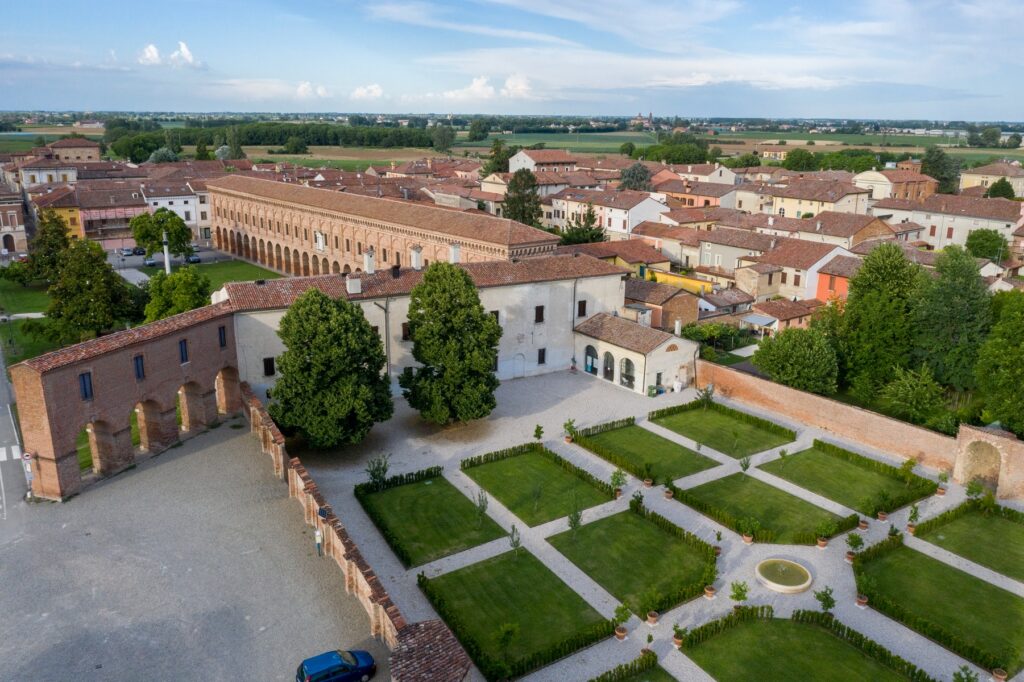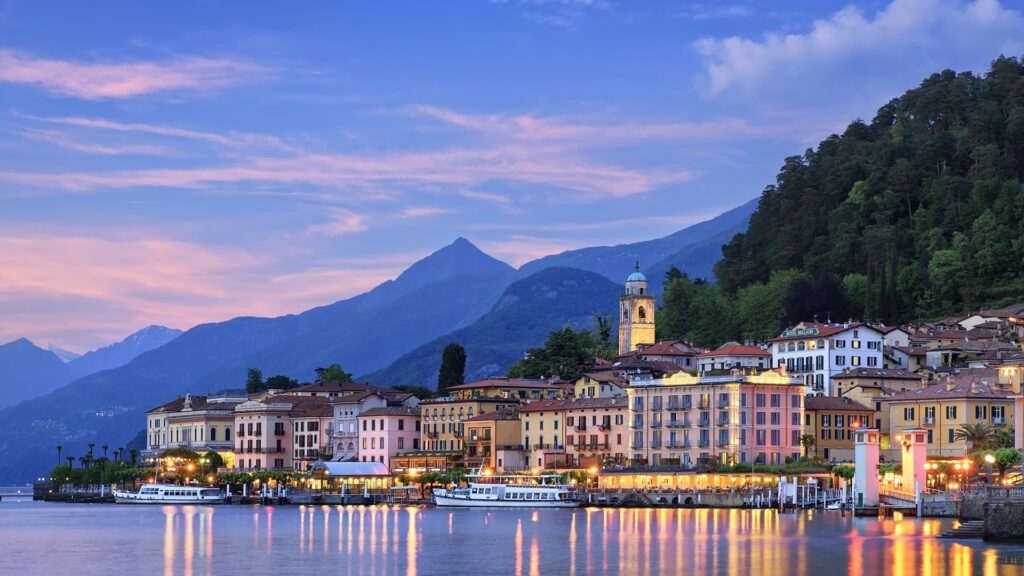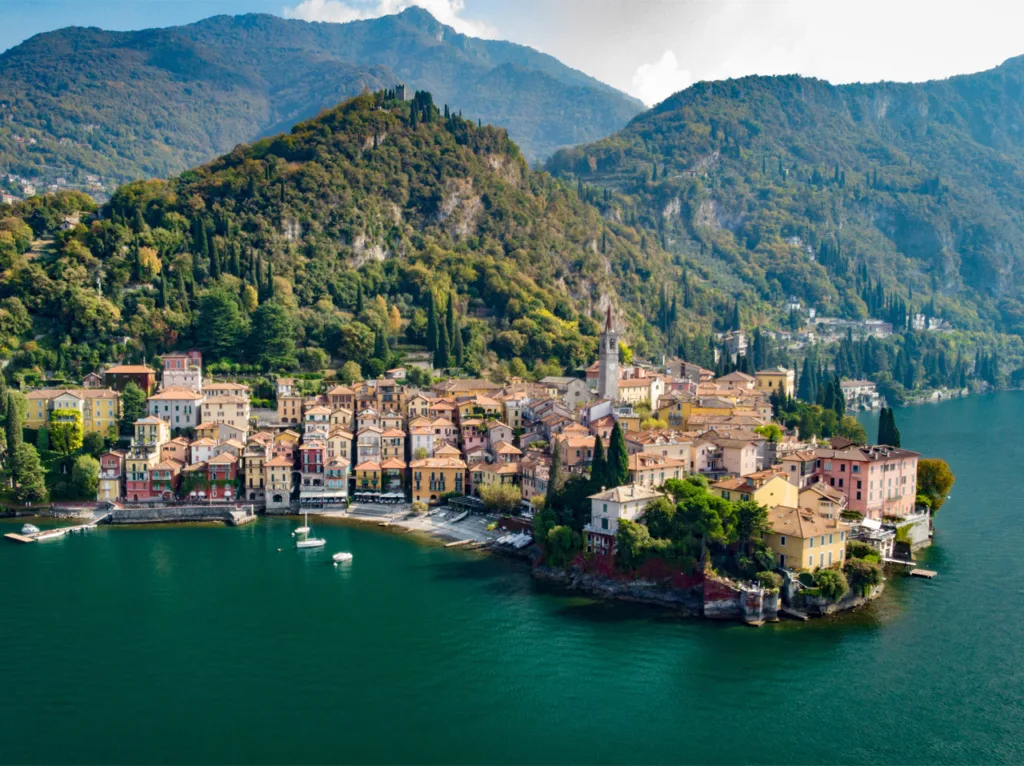Sabbioneta, a UNESCO World Heritage Site since 2008, is small yet complete. This Renaissance “ideal city” was laid out in the 16th century by Vespasiano Gonzaga. Streets meet at right angles, bastioned walls form a compact hexagon, and within them stand palaces, a theater, and a synagogue. The plan remains legible today, and the town is easy to explore on foot.

Table of Contents
ToggleWhy Sabbioneta matters
Vespasiano Gonzaga built Sabbioneta in the late 1500s to reflect order, culture, and defense. It became a model of Renaissance urbanism. The compact plan makes every highlight walkable, and details such as brick gates, formal piazzas, and illusionist frescoes show his vision.
Key takeaways
Clear example of a planned Renaissance town.
Star‑fort bastions and gates survive almost intact.
One ticket usually grants entry to main monuments.
Linked by bus to Mantua and Parma; Casalmaggiore is the closest rail station.
Top things to do in Sabbioneta
Palazzo Giardino and the Galleria degli Antichi
Built in the 1580s, this was Vespasiano’s private retreat. The palace rooms display rich frescoes and stucco. Alongside runs the Galleria degli Antichi, once filled with Roman antiquities. Today visitors walk through a painted corridor with trompe‑l’œil scenes and tall windows.
Teatro all’Antica
Constructed between 1588 and 1590, this free‑standing theater by Vincenzo Scamozzi was among the first of its kind in Europe. The stage set shows a receding street painted in perspective. The auditorium is intimate, so every seat is close to the action.
Piazza Ducale and Palazzo Ducale
This square is the town’s civic heart. The Ducal Palace dominates one side, with interiors that host historic decoration and temporary exhibitions. The square also illustrates the grid plan: each street radiates to a gate.
City walls, bastions, and gates
The six‑point star‑fort is almost intact. Porta Vittoria to the west and Porta Imperiale to the east mark the main axis. Brick and stone details remain on both gates. A short walk outside the walls reveals the angled bastions.
Synagogue and Jewish Sabbioneta
The synagogue, renovated in 1824 in a neo‑classical style, has a double‑height hall with wooden benches and a raised bimah. A women’s gallery overlooks the main space. Exhibits recall the history of the local Jewish community. Visits follow set hours, so confirm times in advance.
A simple walking route (70–90 minutes without museums)
Start at Porta Vittoria, then cross Piazza d’Armi and pause at the Minerva column. Continue to Palazzo Giardino and the Galleria degli Antichi. Head to the Teatro all’Antica, then on to Piazza Ducale for a coffee and the Palazzo Ducale. Visit the Synagogue, and finish at Porta Imperiale. Add a loop outside to view the bastions.
Time tips
One hour covers the core walk.
Add 1.5–2 hours for main interiors.
Allow extra time on summer weekends and during events.
Getting there and around
From Mantua
APAM Line 17 buses reach Sabbioneta in about an hour. Weekday services are more frequent. A signed Mantova–Sabbioneta cycle route follows a flat path through the Po Plain.
From Parma and Casalmaggiore
TEP buses run from Parma to Casalmaggiore and then to Sabbioneta. Casalmaggiore is the closest railway stop. Timetables vary by day, so check ahead.
By car
The old town is a restricted traffic zone (ZTL). Park near Piazza d’Armi or outside the gates. The historic center is compact and walkable.
By bike
The terrain is flat. Surfaces mix tarmac and levee tracks. Carry water and sun cover in warmer months.
Tickets and practical info
A Sabbioneta Single Ticket grants entry to Teatro all’Antica, Palazzo Giardino, the Galleria, and Palazzo Ducale. The Synagogue is occasionally included. Hours shift by season and day. Buy at your first site and keep the receipt.
A combined Mantua + Sabbioneta Card is sometimes sold. Inclusions and prices change, but it can save money if you plan visits in both towns.
Good to know
Interiors often close at lunchtime or one weekday.
Climate control is limited in historic sites.
Floors are flat, but steps appear at some entrances.
Photography rules differ by room.
Where to stay
Inside the walls
Small B&Bs and boutique rooms near Piazza Ducale. Steps from sights, quiet at night, but parking limited.
Near the gates
Guesthouses by Porta Vittoria or Porta Imperiale. Easy access for drivers and cafés close by.
Countryside agriturismi
Farm stays on the Po Plain with gardens, parking, and local food. Five to 15 minutes’ drive.
Mantua (40–60 min)
Wide hotel range and lively evenings. Good for day‑trips.
Parma or Cremona
Choose Parma for food and opera, Cremona for violins. Both combine well with Sabbioneta.
Casalmaggiore
Closest rail stop with simple hotels and B&Bs near the riverfront.
Top Rated Stays in Sabbioneta
🔍Hotel Il Duca barbablu
Score: 8.6 (447 reviews)
Located in Sabbioneta’s centre with a restaurant, bar, and city views. Modern, very clean, and with stable Wi-Fi. Best for travellers who want a central base with dining on site.
Why it stands out: Newly modernised spaces in a quiet setting.🔍Albergo Giulia Gonzaga
Score: 8.9 (383 reviews)
Historic hotel in a 16th- and 20th-century building, featuring classic rooms with antique décor and wood-beam ceilings. Family-run and praised for its charm and central location. Best for travellers who value character and history.
Why it stands out: Period charm and a central address at good value.🔍House Sabbioneta
Score: 9.2 (206 reviews)
Guest house with garden views, free Wi-Fi, and free private parking. Reviews highlight spotless rooms and thoughtful details. Best for travellers who want calm surroundings and convenient parking.
Why it stands out: Clean, well-equipped rooms plus on-site parking inside the walls.🔍B&B da NINA
Score: 8.8 (142 reviews)
Central B&B offering free bikes, on-site parking, and Wi-Fi. Guests praise the friendly host and flexible breakfast options. Best for drivers and those exploring by bike.
Why it stands out: Helpful host and practical perks near the sights.🔍Villa Cantoni Marca
Score: 8.6 (96 reviews)
Guest house with a garden and quiet surroundings. Guests appreciate the manicured grounds and peaceful setting. Best for travellers seeking a green and tranquil stay close to town.
Why it stands out: Spacious property with a park-like atmosphere.
When to visit and events
Spring and autumn are mild and bright. Summer is hot at midday, while winter brings fog that suits the brick townscape. Weekends are busier with tours. Early morning is best for a quiet visit.
Events
July fair with music and stalls.
October San Gallo fair.
Concerts and cultural events in the theater and palaces.
Suggested half‑day plan
Morning
Enter at Porta Vittoria and cross Piazza d’Armi.
Visit Palazzo Giardino and the Galleria.
Coffee on Piazza Ducale.
Explore the Teatro all’Antica before groups arrive.
Lunch
Dine in a trattoria inside the walls or near the gates.
Try pumpkin tortelli or risotto from the Po Valley.
Afternoon
Tour the Ducal Palace.
Visit the Synagogue if open.
Stroll along the walls and view the bastions.
Background in brief: the “ideal city”
Renaissance rulers used geometry to impose order. Vespasiano Gonzaga planned Sabbioneta with a strict grid and a star‑fort shell. The main axis linked two gates and a central square. The theater expressed courtly taste for performance. The palace and gallery displayed learning and power. After Vespasiano’s death in 1591, the town’s influence declined, but its urban plan remained intact.
FAQ
What is Sabbioneta best known for? A 16th‑century planned town with intact walls, a purpose‑built theater, and UNESCO recognition shared with Mantua.
How long do I need? Half a day works for highlights; a full day allows time for interiors and a slower pace.
Can I visit without a car? Yes. Buses connect Sabbioneta with Mantua, Casalmaggiore, and Parma. Schedules change on weekends and holidays.
Is there a combined pass with Mantua? Yes, sometimes. Inclusions vary. Confirm details before travel.
Is the historic core a ZTL? Yes. Park outside and continue on foot.
Are there good cycling options? Yes. The signed Mantova–Sabbioneta route is flat and easy. Levee paths offer extra mileage.
Responsible visiting
Keep voices low in the theater and synagogue. Do not touch decorated walls or stucco. Avoid tripods where restricted. Support small cafés in the piazza. Carry litter out of the walls. Respect residents on side streets.
Map your stop between Mantua and Parma
Sabbioneta fits into a Lombardy itinerary. Pair it with Mantua’s palaces or Cremona’s violin workshops. Add a night in Parma for its food culture. Set aside half a day here to see how Renaissance ideas turned into streets and squares.
Disclosure: This page may contain affiliate links. This means that we get a small commission from any purchase you make, at no additional cost to you!

